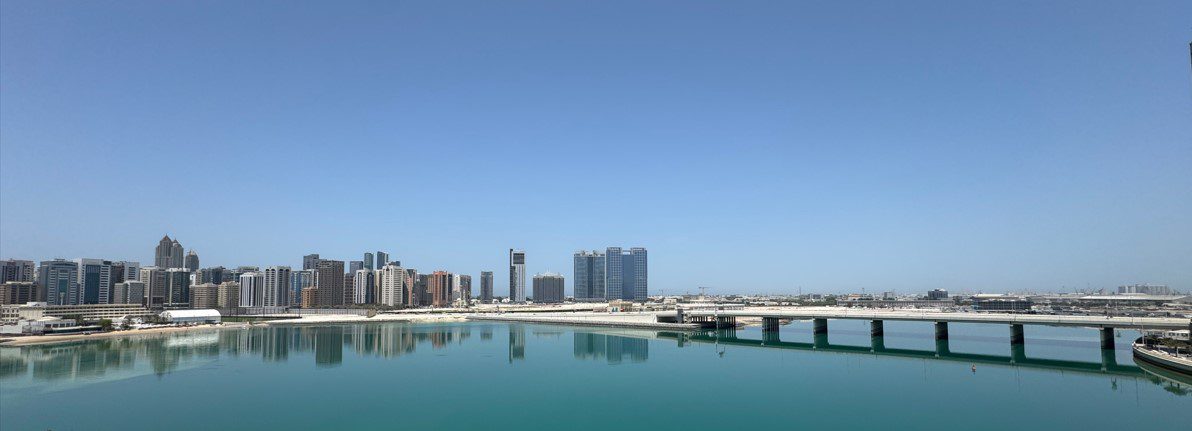Ted Rogers School students recently gained invaluable international experience on an experiential learning trip to the United Arab Emirates (UAE), where they dove deep into the world of luxury retailing and hospitality. This immersive journey was part of the RMG917: Experiential Learning – Travel Study course.
The course is designed to fully prepare students for their international adventure. It does this by exploring a key retail theme through dedicated classroom instruction and virtual guest lectures from experts in the destination country. The trip itself serves as the hands-on culmination, allowing students to directly apply and deepen their understanding of the chosen theme in a real-world setting outside of Canada.
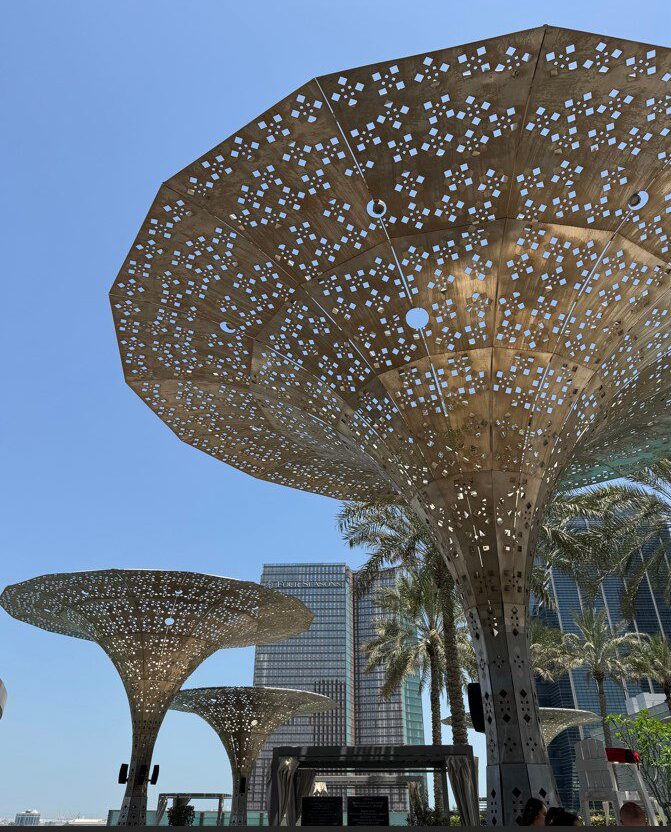
This year’s study trip to the UAE focused on luxury consumption. It was a collaborative effort between Retail Management and the School of Hospitality and Tourism Management (HTM). This rich experience brought together a diverse group of 25 individuals, including nine retail students, seven HTM students, one journalism student, and notably, several students from the previous year’s course who were so intrigued by this year’s theme and destination that they joined again. Retail Professor Dr. Donna Smith and HTM Professor Dr. Frédéric Dimanche accompanied the students on the trip.
From April 28 to May 5, 2025, students spent an immersive week in the heart of a leading global luxury market, exploring cutting-edge practices in two of the world’s most forward-thinking cities: Dubai, which is renowned as a global hub for luxury retail and tourism, and Abu Dhabi, which provided a strong business and cultural context to their learning.
Beyond business insights, culture played a central role. The group visited iconic landmarks such as the Dubai Museum of the Future and the Louvre Abu Dhabi, and connected with professionals serving customers from over 250 cultural backgrounds. They returned with a greater appreciation for global perspectives, cultural diversity and the transformative power of experiential learning.
Here is what a few students had to say about their experience:
The Intersection of Retail and Hospitality in Dubai
Ishvani Persad, Retail Management
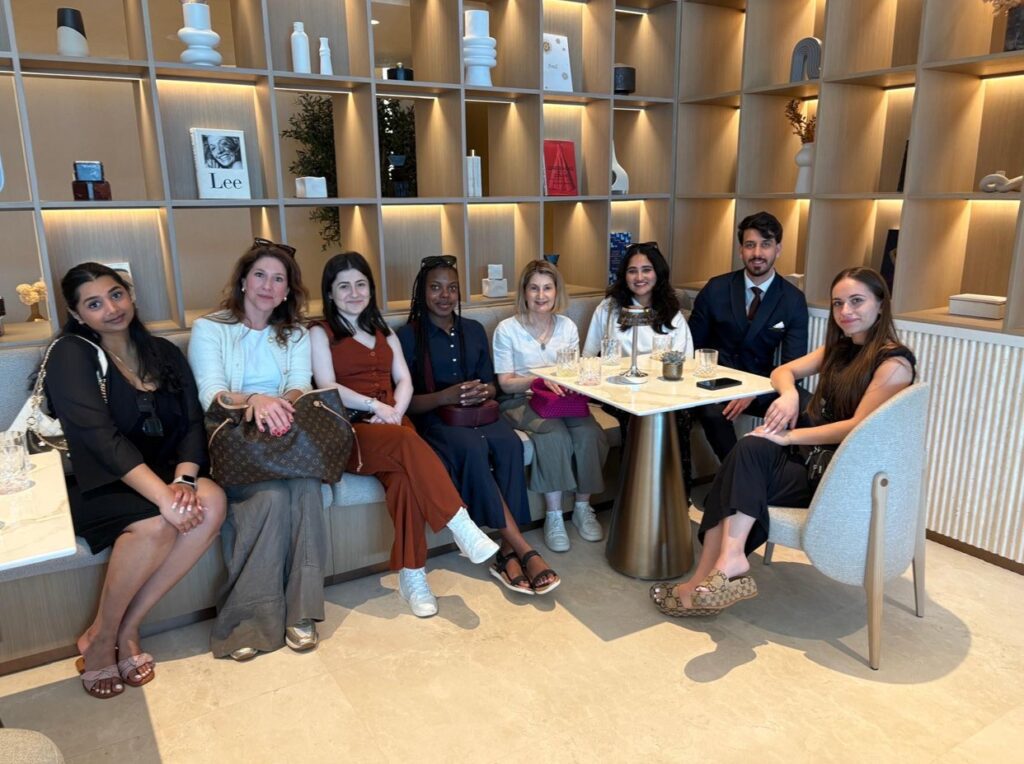
During my time in Dubai, two experiences deeply resonated with me and beautifully illustrated how retail and hospitality can seamlessly come together:
Dubai Mall
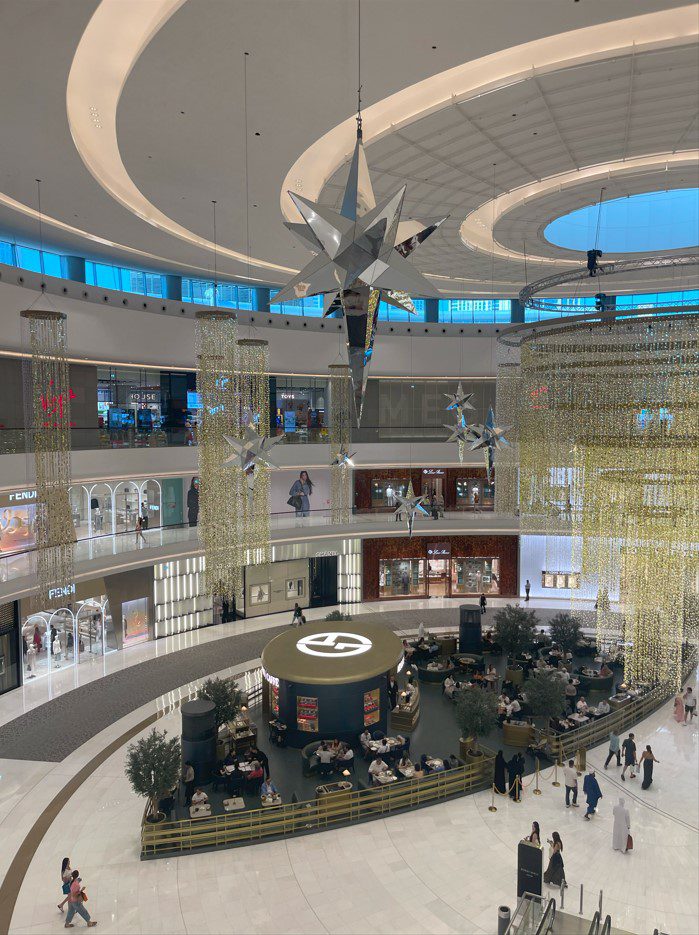
The first experience was our visit to the Dubai Mall, a place that redefined what shopping could feel like. One of the standout features was KidZania, an immersive, interactive children’s city that brings the concept of “learn through play” to life. The “Kids Zone” introduces an element of luxury hospitality within a family-friendly space, allowing parents to enjoy their shopping while their children engage in an experience that mimics real-world careers. This thoughtful integration of entertainment and retail aligns perfectly with the mall’s design, ensuring that all customers, regardless of age, feel valued and catered to.
The VIP lounge at Dubai Mall added another layer of luxury hospitality to the retail experience. For high-end shoppers or those looking to elevate their visit, this lounge offers an exclusive retreat from the hustle and bustle of the mall. With its plush seating, gourmet refreshments and personalized services, it’s a space designed to make customers feel like they are the priority. The lounge serves as a reminder that luxury retail isn’t just about the products; it’s about crafting an environment where guests feel pampered, relaxed and valued throughout their entire visit.
But what really stood out for me, surprisingly, was the client advisor service. Our guide, Mahdi Merzoug, a Brand Ambassador at the Dubai Mall, was exceptional. He took the time to walk us through every corner of the mall, offering insights not only about the stores, but also about the thoughtfulness that went into the space. It felt less like a typical mall tour and more like a genuine effort to make us feel seen and valued. This wasn’t just retail; it was hospitality in its purest form, blending personal touches with attention to detail to create an unforgettable experience.
Lamborghini showroom
The second experience was a visit to the Lamborghini showroom. What I didn’t expect was how human and approachable the sales team was. Lamborghini is known for its flashy cars, sleek designs and performance. But the magic of the brand, in my opinion, goes far beyond that. The sales team isn’t just trying to sell you a car. They genuinely want to ensure your experience is exceptional, whether you’re a first-time buyer, an avid collector or just a fan of the brand.
What I saw there wasn’t just about cars, it was about connection. Although we were there on an educational visit, the impression that I got was that they treat every customer with respect and care, making you feel like your experience mattered. They aren’t concerned about your status or who you are buying for. They are focused on making you feel like a part of the Lamborghini family.
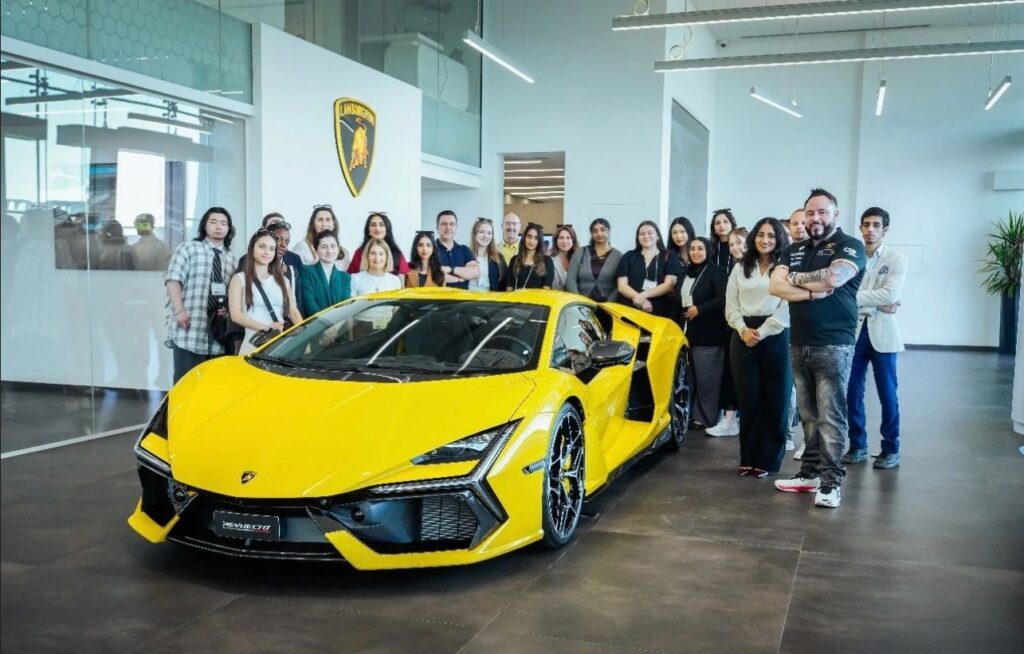
We even got the chance to sit down with Richard Weinberg, the Lamborghini Brand Manager for Abu Dhabi and Dubai, who shared insights into their post-purchase practices. The brand doesn’t stop at the sale; they celebrate it with special handover ceremonies and exclusive events. The thoughtfulness of these gestures underscored how hospitality is woven into the fabric of luxury retail. It wasn’t just about the car. It was about creating lasting memories and fostering a sense of community.
Looking back at both experiences, I’ve come to realize that the real intersection of retail and hospitality in Dubai is the people. It’s the passion they bring to their work and their genuine desire to make others feel valued. Whether you’re in retail or hospitality, success comes down to passion, authenticity and service excellence. As I make my way into the world of retail, this is something that I will take with me throughout my career.
Luxury Hospitality as a Strategic Choice
Bianca Cantor, Hospitality and Tourism Management
The United Arab Emirates has strategically positioned itself as a global luxury destination – using hospitality as a powerful tool to build its brand, attracting elite travellers and setting itself on the world stage. During our week-long stay, we toured two standout hotels:
JW Marriott Marquis in Dubai

The JW Marriott Marquis in Dubai is the tallest 5-star hotel in the world and known by its two iconic towers overlooking the city. This stunning property is located in the Business Bay right beside the Dubai Water Canal. From the moment we arrived, luxury strategy was on full display: valet-parked supercars lined up on a dramatic red carpet, and a towering four-storey glass lobby filled with marble, a large orchid display and extravagant chandeliers.
The space felt intentionally oversized. For my final paper in this course, I read that large spaces are associated with exclusivity and wealth. Unlike Toronto’s moody boutique-style hotels, this property commands attention, using space and spectacle as strategic tools to attract international business and leisure travelers. For the UAE, luxury isn’t quiet, it’s loud.
Something else that stood out to me was the sensory branding: a signature scent diffused through the air ducts into the lobby, courtesy of AirScent, which guests can even purchase! This tactic creates an emotional memory and brand loyalty, subtly keeping Marriott in the guests mind long after they dept. It’s clever and continuous marketing.
During our in-depth presentation of the property with Kamila Siedlecka, we learned about their initiatives to promote sustainability and help reach UAE’s goal of banning plastic by 2026. Marriott is developing in-house water bottling systems to eliminate single-use plastics, which is a decision that appeals to environmentally-conscious guests and supports national goals. Through this they are able to replace all their plastic bottles with reusable glass bottles.
Furthermore, an initiative that was brought forth due to high demand from clientele is their pet-friendly rooms, where guests can bring two of their furry friends along with them, a rarity in UAE hotels, giving this Marriott property a competitive advantage.
Rosewood Abu Dhabi
Our visit to the Rosewood Abu Dhabi introduced us to a brand many of us had not heard of. Unlike the grandeur of the Marriott in Dubai, the Rosewood offered a quieter, more refined luxury. From the minimalist entrance, wooden accents and orchid displays covering elegance.

What impressed me the most was Rosewood’s commitment to “relationship-based luxury.” Their presenter emphasized that, “Luxury is about personalization, so I do not think we will ever adapt to fully tech. The experience has to be about the people, not the technology.” In this day and age, many hotels are racing toward automation, stripping the authenticity from the experience, but Rosewood deliberately chooses to keep things human. This strategic positioning focuses on emotional connection with the guest over digital convenience to build long-lasting loyalty and elevate their brand. I personally adore this because for me, luxury is just that: elegant, timeless and irreplaceable.
Rosewood also does quiet marketing, using social media and influencer campaigns rather than bold and large scale advertising. This supports their image of exclusivity, allowing them to target a curated audience, reinforcing the idea that their luxury is not for everyone, only for those chosen few.
What became clear during our trip is that luxury hospitality in the UAE goes beyond opulence. It has become part of their nationwide strategy to attract high-spending tourists, host global events and build a reputation of excellence. This goes from the various orchid displays we saw at various properties, to personalized greetings and scent branding, all contributing to the guest’s journey.
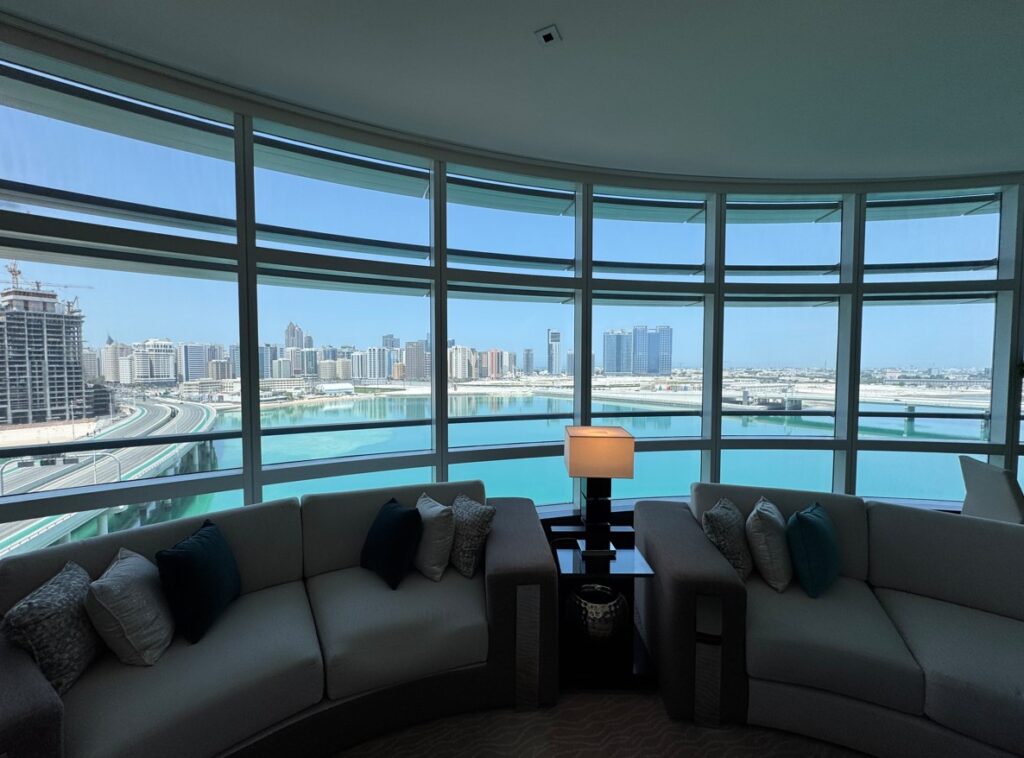
Cultural Impressions
Keisi Nderjaku, Hospitality and Tourism Management
As a Hospitality and Tourism Management student with a deep passion for cultural experiences, I had the incredible opportunity to explore some of Abu Dhabi’s most symbolic heritage sites. These visits weren’t just sightseeing stops, they were immersive experiences that deepened my understanding of Emirati culture, tradition and hospitality. From witnessing the artistry of local women to standing in the presence of architectural grandeur, the journey was extremely inspiring.

Women’s Handicrafts Centre: A Living Heritage
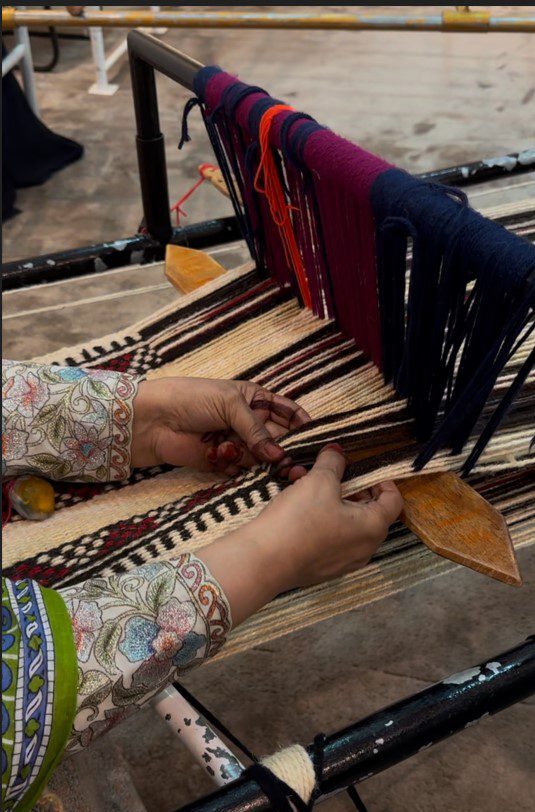
Our cultural journey began at the Women’s Handicrafts Centre, located in the heart of Abu Dhabi. This wasn’t your typical museum, it was a space alive with the spirit of tradition. As we walked through the workshops, I was immediately drawn to the vibrant contrast of brightly coloured undergarments peeking out from under the traditional black abayas. Many women wore golden face masks, which added a sense of mystique and cultural pride to their presence.
The experience of watching them work was fascinating. Each piece, whether it was woven fabric, silver thread embroidery or handmade incense, was crafted with precision, care and deep cultural significance. The artisans shared insights about Al Sadu weaving, an age-old tradition where sheep’s wool is transformed into cushions, tent dividers and decorative furnishings using natural dyes. I was also fascinated by the pottery section, where designs told silent stories of tradition and functionality.
Before leaving, I purchased a woven piece as a souvenir, a small but meaningful way to support the talented women keeping these crafts alive. This experience reminded me that in the UAE, handicrafts are more than just creations, they are carriers of cultural identity and symbols of empowerment for Emirati women.
Qasr Al Hosn: The Heart of Abu Dhabi’s Story
Our next stop took us to Qasr Al Hosn, the oldest stone building in Abu Dhabi. As we walked through its entrance, I couldn’t help but feel the weight of history around me. Known as the “witness to Abu Dhabi’s past,” the building has transformed into a captivating museum that tells the story of the city’s evolution, from a humble fishing/pearling village to a modern global metropolis.
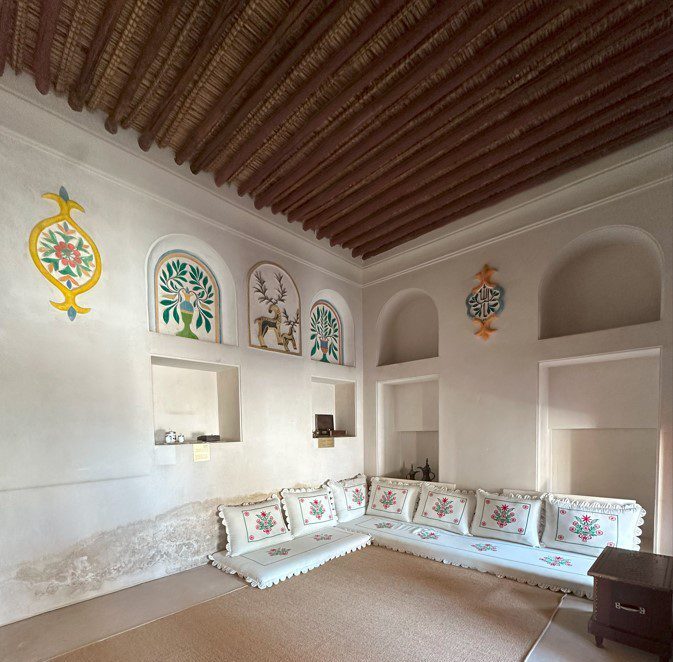
The building’s architecture was breathtaking. Simple yet elegant, its walls seemed to convey tales of resilience and growth. Inside, we explored rooms filled with artifacts, each offering a glimpse into the daily lives, struggles and victories of those who came before. The spacious courtyard and intricate designs showcased the Emirati love for both beauty and functionality.
As a student of hospitality and tourism, I admired how Qasr Al Hosn manages to preserve authenticity while offering a meaningful visitor experience. It’s not just about looking at history, it’s about experiencing it firsthand.
Sheikh Zayed Grand Mosque: A Monument of Unity and Faith
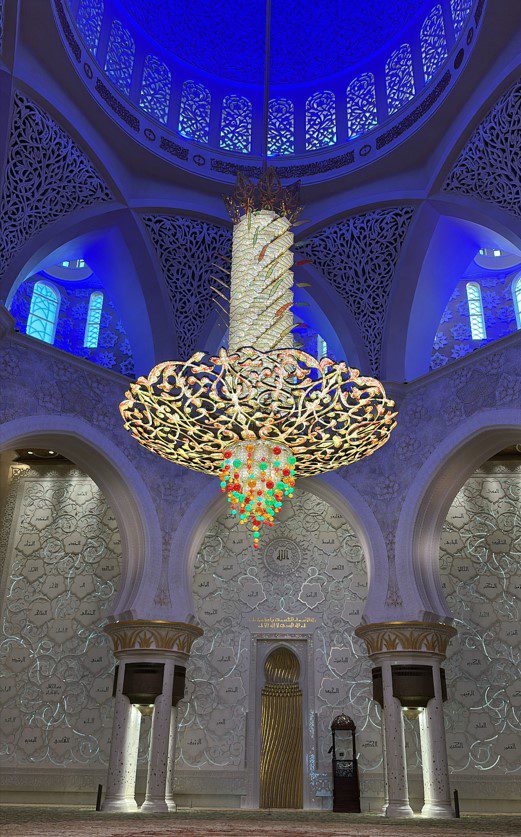
No trip to Abu Dhabi would be complete without visiting the iconic Sheikh Zayed Grand Mosque. Even before stepping foot inside, the sheer scale of this architectural masterpiece left me stunned. Built over 11 years and incorporating materials and craftsmanship from around the world, the mosque truly lives up to its vision of uniting the global Islamic world under one remarkable roof.
Inside the Grand Mosque, the beauty intensified. The chandeliers, inspired by date palm trees, sparkled with crystals and Islamic motifs. The largest one hung majestically in the center of the main prayer hall, its floral design echoed in the massive handwoven carpet beneath it. I couldn’t help but look up and down repeatedly, admiring the way the symmetry and design worked together in perfect harmony.
The mosque wasn’t just a visual masterpiece, it was an emotional experience. Standing in the main prayer hall that can accommodate over 7,800 worshippers, I was reminded of the mosque’s role not only as a place of worship, but also as a symbol of tolerance, community and spirituality.
We also learned about mosque etiquette and the importance of respect in sacred spaces. Modest dress, quiet voices and a reverence for the surroundings were all part of the experience, reinforcing the deep values that underpin Islamic hospitality.
Reflection
These cultural tours were a highlight of my academic journey. It gave me direct insight into how heritage, hospitality and tourism intersect in powerful ways. Whether it was engaging with local artisans or exploring centuries-old buildings, I gained a deeper appreciation for the UAE’s commitment to preserving its identity while welcoming the world.
As future professionals in the hospitality industry, it’s essential to understand the soul of a place, not just its tourist attractions. This trip to Abu Dhabi wasn’t just educational; it was transformative. It reminded me that true hospitality begins with understanding and respect for culture, history and people.
Sustainability Contrasts
Alessia Pugliese, Retail Management
The Dubai brand has been cleverly designed to impress visitors, whether they find themselves in the city for business or pleasure. The city is a marvellous place where you can sip organic kale smoothies in a solar-powered villa and, an hour later, carve down a snowy slope inside a multi-level shopping mall. Welcome to the city where sustainability and spectacle coexist in a uniquely dazzling dance…but it works!
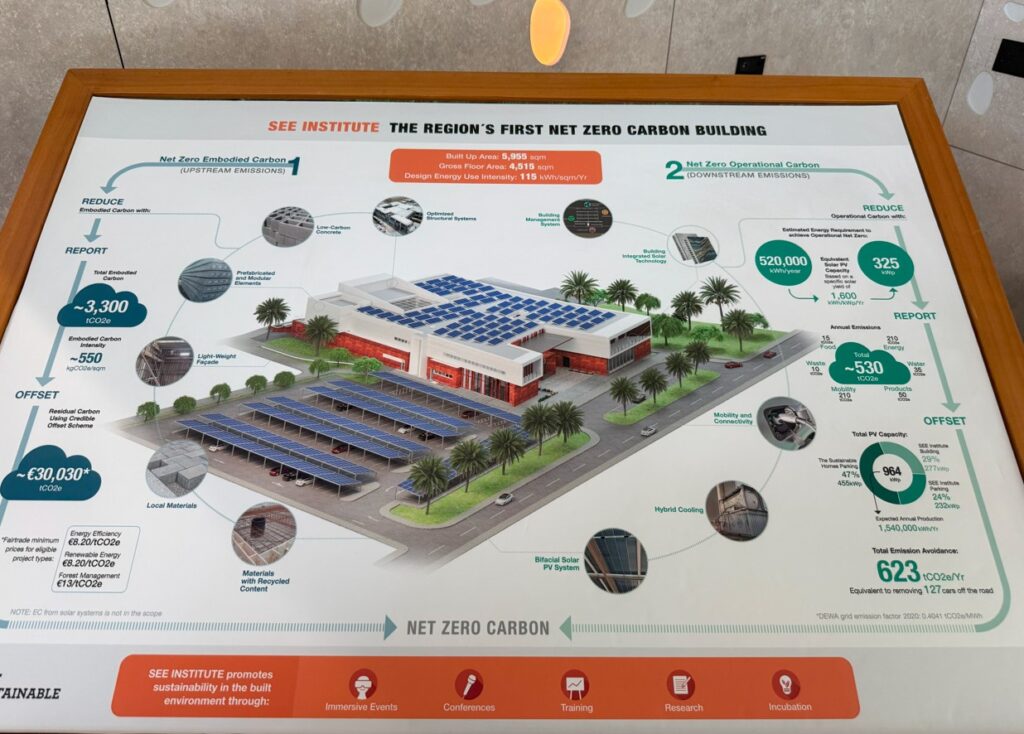
The Sustainable City: Dubai’s Eco-Oasis
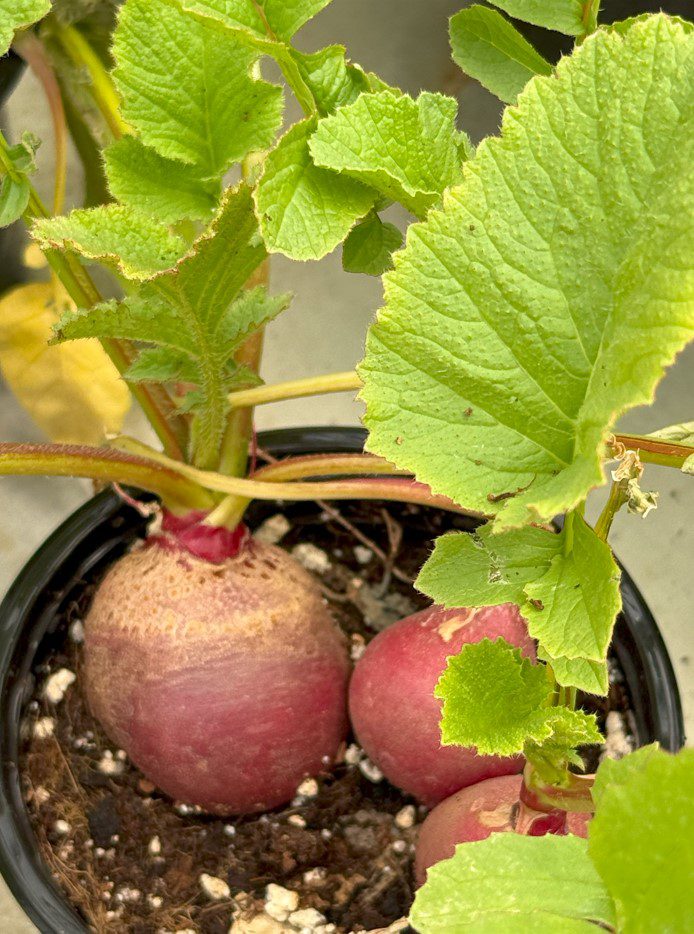
Our first business meeting on the trip began with a visit to The Sustainable City, an innovative eco-community that seamlessly blends luxury and comfort with the latest sustainable advancements. Nestled in the desert, soon after the presentation started, I realized that The Sustainable City development is a masterclass in green living. The impressive community isn’t just a collection of eco-friendly, stunning villas; it’s a living, breathing model of what urban sustainability can look like, starting with the design and positioning of the houses situated to minimize sun exposure during peak heat hours and moving to the many practices weaved into the site’s operations and designed to cater an outstanding experience to its residents – one that feels luxurious at every touchpoint.
During our tour, we visited one of the 11 biodomes that produce organic food; the food can, in turn, be sold to the residents, who can also rent a portion of the biodomes for their own personal use. We saw solar panels adorning every rooftop, enjoyed car-free zones that promote pedestrian and cycling traffic, helping the environment while also promoting the well-being of its residents, and marvelled at the horse trail that flanks the entire perimeter of the development. Residents live in smart homes with energy-efficient appliances, while local businesses and community facilities underscore the city’s commitment to the inclusivity and well-being of its residents.
Snowy Slopes in the Sands, Anyone?
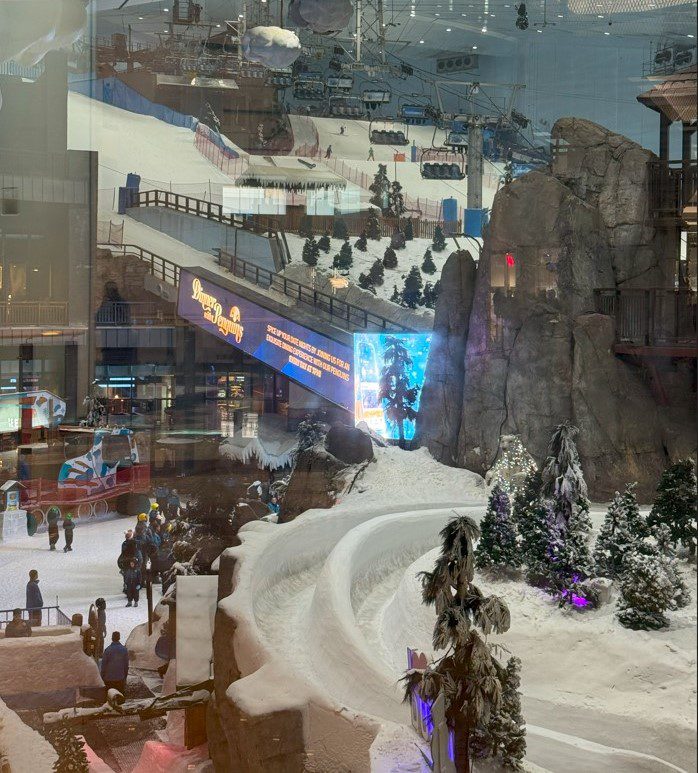
Close to our hotel and just a short drive away from the development, Ski Dubai offers a stark contrast. Nestled in the Mall of the Emirates, this indoor ski resort brings alpine adventures to the desert. With temperatures maintained at -3°C, visitors can ski, snowboard, have a snowball fight and even meet penguins from January to December—all while outside temperatures soar above 40°C.
The concept is undeniably innovative and convenient because it addresses the seasonality of winter sports; however, it raises important questions about sustainability that often arise while strolling through Dubai. In this case, efforts have been made to mitigate environmental impact. The ski hill recycles water used in snow production and employs energy-efficient systems to reduce its carbon footprint.
Contrasting Visions: Harmony or Dissonance?
As we spent more time in the UAE, it became evident that the juxtaposition of The Sustainable City and Ski Dubai encapsulates Dubai’s broader narrative—a city striving to balance rapid and clever development with environmental responsibility.
On the one hand, The Sustainable City represents a forward-thinking approach to urban planning, emphasizing renewable energy, waste reduction and community well-being, all themes that, based on what we learned on our business visits during the trip, seem extremely relevant across all industries in the UAE. On the other hand, Ski Dubai and many other attractions, such as the skating rink at Dubai Mall and the Dubai Miracle Garden, with its creative and Instagram-worthy REAL floral displays, exemplify the city’s predilection for grandeur and its ability to challenge natural limitations through technology and the relentless pursuit of excellence (in Dubai, luscious plants and flowers of the most vibrant colours beautify every public space and adorn all the private ones).
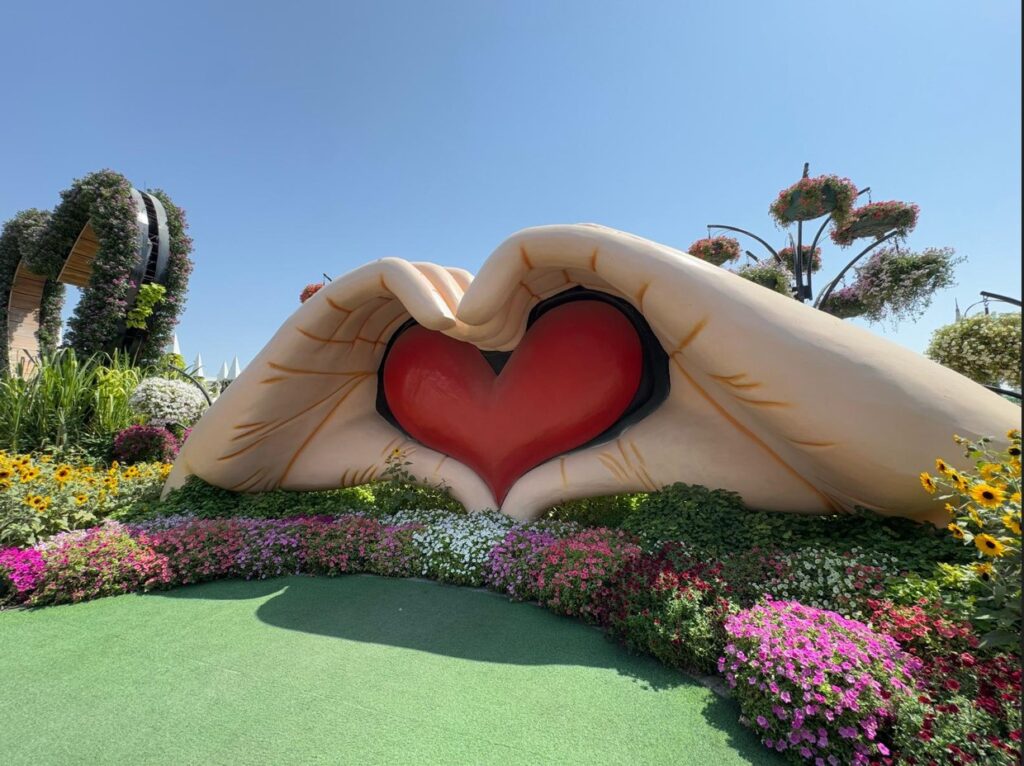
This duality then prompts a serious reflection: Can a city pursue ambitious, luxurious and wildly entertaining projects while genuinely committing to sustainability? For Dubai, the answer seems to be a resounding “yes,” as the city aims to integrate eco-conscious practices at every step, even within its most extravagant ventures.
A City of Paradoxes, Possibilities or Both?
I concluded that Dubai is a city of paradoxes – where solar-powered communities and indoor snow parks co-exist, but also a city of many possibilities with a fierce commitment to excellence embedded in every experience, from the simplest to the most complex. This blend of innovation, cleverness and extravagance challenges conventional notions of sustainability, suggesting that environmental responsibility and ambitious development aren’t mutually exclusive if one is willing to commit to and invest in both.
Once I got past the UAE’s beauty and marvel, Dubai prompted me to ponder: Can the thrill of skiing in the desert coexist with the tranquility of a sustainable community? In this city of dreams and contradictions, my answer is “yes.” Dubai is well aware that its natural resources, like those of any other country in the world, are not infinite, and it is actively working to preserve them while also finding its place in the world.
After this fun, informative and intellectually stimulating trip, I can confidently say that it is obvious what the fuss is all about and that Dubai. With the city’s beauty and contradictions and countless ways of achieving excellence, it should be on the list of places to visit for all those seeking to understand what a passionate commitment to excellence can achieve. It is a place that those interested in luxury retail and hospitality must put on their map because Dubai excels in both.
